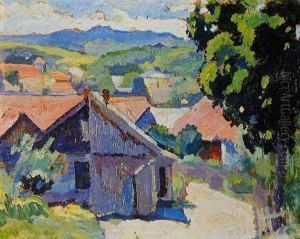Kazimierz Strzeminski Paintings
Kazimierz Strzemiński was a pioneering Polish painter, theorist, and educator, deeply influential in the development of avant-garde art in the 20th century. Born on November 21, 1893, in Minsk, then part of the Russian Empire (now Belarus), Strzemiński navigated through the tumultuous times of World War I and II, embedding his experiences and observations into his evolving art practice. Despite losing an arm and a leg during World War I, Strzemiński's spirit and dedication to art remained unshaken, and he continued to develop his unique artistic vision, contributing significantly to modernist movements.
After the war, he settled in Poland and became a central figure in the formation of the Polish avant-garde, co-founding several influential groups and movements, including Blok (1924-1926), Praesens (1926-1929), and a.r. group (1929-1936), which stood for 'revolutionary artists' or 'real avant-garde'. His theoretical work was also groundbreaking, particularly his theory of Unism, articulated in the 1928 book 'Theory of Vision'. Unism proposed that the unity between the form and content of an artwork was essential, arguing for the integration of visual elements to the extent that the distinctions between them disappear, creating a uniform, harmonious whole. This concept had a profound impact on the development of abstract art in Poland and beyond.
Strzemiński's commitment to modernist ideals extended to his teaching career. In 1945, he was instrumental in establishing the State Higher School of Visual Arts (now the Władysław Strzemiński Academy of Fine Arts) in Łódź, where he taught until 1950. His pedagogical methods emphasized the importance of studying both the formal aspects of art and the socio-political context in which it exists, preparing his students to engage critically with the art world. However, his career was marred by political challenges; the rise of socialist realism as the official art form of communist Poland conflicted with his modernist ideals, leading to his dismissal from the Academy.
Despite facing significant obstacles, including political ostracism and severe health issues, Strzemiński never ceased to create, theorize, and inspire. His later works, which included the 'Solarism' series, continued to explore the interaction of light and color, demonstrating his unwavering commitment to avant-garde principles. Kazimierz Strzemiński passed away on December 26, 1952, in Łódź, Poland. His legacy lives on through his contributions to modern art theory, his influential artworks, and the generations of artists and students he inspired.



